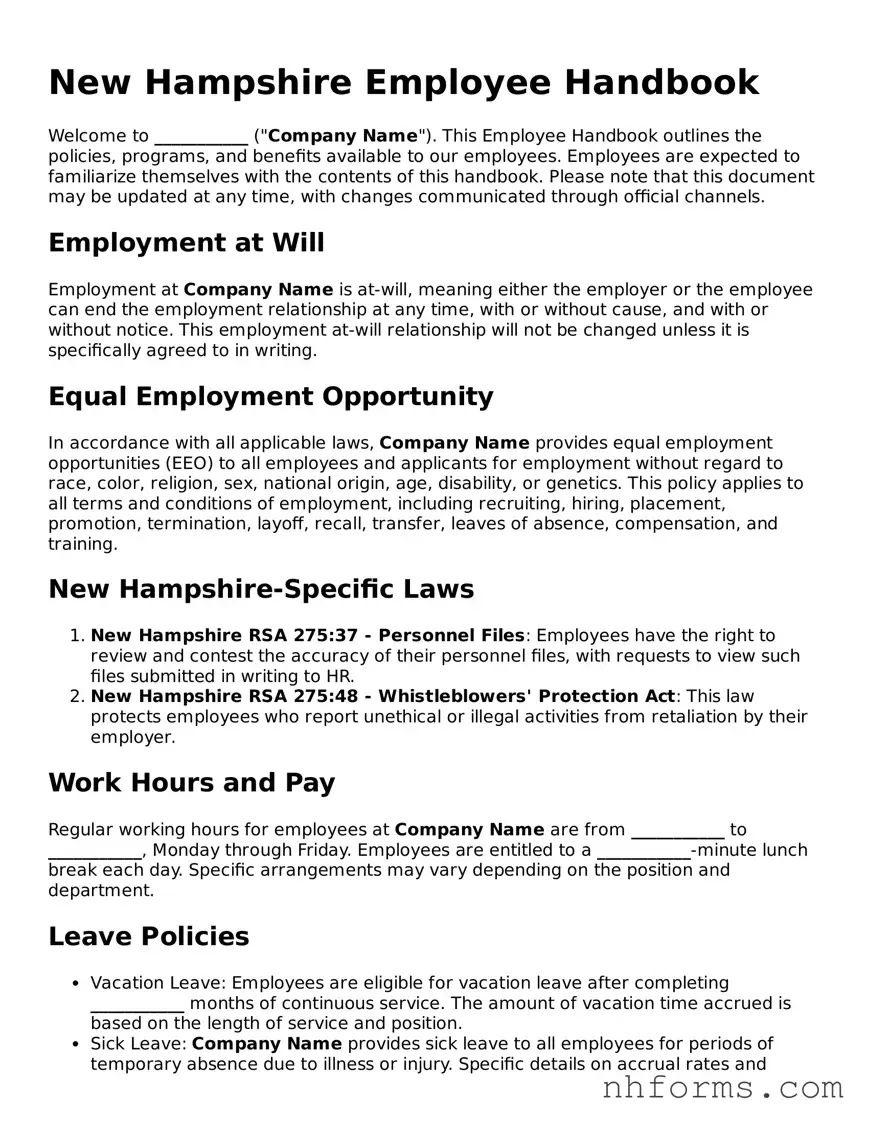New Hampshire Employee Handbook
Welcome to ___________ ("Company Name"). This Employee Handbook outlines the policies, programs, and benefits available to our employees. Employees are expected to familiarize themselves with the contents of this handbook. Please note that this document may be updated at any time, with changes communicated through official channels.
Employment at Will
Employment at Company Name is at-will, meaning either the employer or the employee can end the employment relationship at any time, with or without cause, and with or without notice. This employment at-will relationship will not be changed unless it is specifically agreed to in writing.
Equal Employment Opportunity
In accordance with all applicable laws, Company Name provides equal employment opportunities (EEO) to all employees and applicants for employment without regard to race, color, religion, sex, national origin, age, disability, or genetics. This policy applies to all terms and conditions of employment, including recruiting, hiring, placement, promotion, termination, layoff, recall, transfer, leaves of absence, compensation, and training.
New Hampshire-Specific Laws
- New Hampshire RSA 275:37 - Personnel Files: Employees have the right to review and contest the accuracy of their personnel files, with requests to view such files submitted in writing to HR.
- New Hampshire RSA 275:48 - Whistleblowers' Protection Act: This law protects employees who report unethical or illegal activities from retaliation by their employer.
Work Hours and Pay
Regular working hours for employees at Company Name are from ___________ to ___________, Monday through Friday. Employees are entitled to a ___________-minute lunch break each day. Specific arrangements may vary depending on the position and department.
Leave Policies
- Vacation Leave: Employees are eligible for vacation leave after completing ___________ months of continuous service. The amount of vacation time accrued is based on the length of service and position.
- Sick Leave: Company Name provides sick leave to all employees for periods of temporary absence due to illness or injury. Specific details on accrual rates and usage limitations are provided separately.
- Family and Medical Leave: Eligible employees are entitled to take unpaid, job-protected leave for specified family and medical reasons, consistent with the federal Family and Medical Leave Act (FMLA) as well as any applicable state-specific laws.
Disciplinary Procedures
At Company Name, we aim to maintain a productive and positive work environment. The disciplinary process is designed to be fair, consistent, and administered in a manner that respects the dignity of all employees. Disciplinary actions, up to and including termination, may occur for violations of company policies or conduct detrimental to the operations or reputation of Company Name.
Receipt and Acknowledgment
I, ___________(Employee Name), acknowledge that I have received, read, and understand the Company Name Employee Handbook. I agree to abide by the policies and procedures detailed within it and understand that this handbook is not a contract of employment. I further understand that the company retains the right to modify, revoke, suspend, terminate, or change any or all policies and procedures at its discretion.
